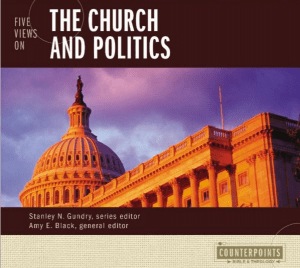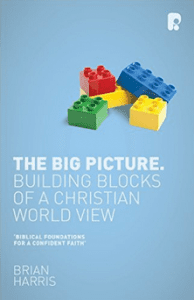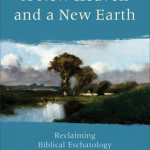 Last month I introduced a new book Let Creation Rejoice: Biblical Hope and Ecological Crisis by Jonathan Moo and Robert White (courtesy of the publisher, IVP Academic) and promised a series of posts. Jonathan Moo is an assistant professor of biblical studies at Whitworth University in Spokane Washington. According to his biography at the Faraday Institute he holds undergraduate degrees in Biology and English (Lake Forest College), and graduate degrees in Wildlife Ecology (MS, Utah State University), and Theology (MA Old Testament, MA New Testament, both from Gordon-Conwell, PhD, Cambridge). Robert White is professor of geophysics at the University of Cambridge UK, PhD Cambridge. They are both deeply concerned with what is often called “creation care” and the biblical mandate for human interaction with the earth on which we live.
Last month I introduced a new book Let Creation Rejoice: Biblical Hope and Ecological Crisis by Jonathan Moo and Robert White (courtesy of the publisher, IVP Academic) and promised a series of posts. Jonathan Moo is an assistant professor of biblical studies at Whitworth University in Spokane Washington. According to his biography at the Faraday Institute he holds undergraduate degrees in Biology and English (Lake Forest College), and graduate degrees in Wildlife Ecology (MS, Utah State University), and Theology (MA Old Testament, MA New Testament, both from Gordon-Conwell, PhD, Cambridge). Robert White is professor of geophysics at the University of Cambridge UK, PhD Cambridge. They are both deeply concerned with what is often called “creation care” and the biblical mandate for human interaction with the earth on which we live.
The second chapter Life on Earth Today looks at the ways in which human activity has changed the earth. Not all of these changes are negative or destructive, but it is clear that some are, some have been, and dire consequences are possible. They are not calling on us to hang our heads in despair, but to look to an appropriate Christian response.
The first thing we must realize according to Moo and White is that the earth is of finite size with a quantifiable amount of natural resource. There is a limit to sustainable population growth.
Estimates of the sustainable carrying capacity of the earth vary widely according to what assumptions are made, but most lie in the range of 6 to 14 billion people, with the most common being 6 to 8 billion, roughly the same as the present global population. The question that all such estimates raise, however, is just what we mean by sustainable and to what extent we include humankind’s impact on the rest of life on earth. (p. 30)
They look at five global issues that face mankind.
 1. Biodiversity. Extinctions are occurring at an accelerated rate and many of these are the result of human activity. Dodos (picture to the right), passenger pigeons, golden toads, and much, much more. Moo and White note that “on average one species on earth goes extinct every eight hours.” (p. 35) Most of these are not as romantic as dodos, passenger pigeons or quaggas (look it up), but even for insects the loss of biodiversity is a concern.
1. Biodiversity. Extinctions are occurring at an accelerated rate and many of these are the result of human activity. Dodos (picture to the right), passenger pigeons, golden toads, and much, much more. Moo and White note that “on average one species on earth goes extinct every eight hours.” (p. 35) Most of these are not as romantic as dodos, passenger pigeons or quaggas (look it up), but even for insects the loss of biodiversity is a concern.
Why should we care about loss of biodiversity? Apart from aesthetic or moral considerations, one reason is that as humans we rely on living systems to keep our air breathable, our water drinkable, and to provide us with sufficient food. Loss of biodiversity makes the ecosystem vulnerable to diseases and other disasters thaht could wipe out species on which we depend. … The loss of even a few species in a complex interacting ecosystem can greatly reduce its resilience to change and make it vulnerable to catastrophic and irreversible failure. (p. 35)
They bring up bees as an example. Bees are under assault in many ways, with populations dropping – and pesticides appear the culprit (one recent story Why is Canada’s bee population in rapid decline?). Moo and White: “Already, wild honeybees are thought to be nearly extinct throughout the British Isles, and the number of managed honeybee colonies in the UK fell by 53% between 1985 and 2005.” (p. 35-36) And from a USDA news release:
More than $15 billion worth of agricultural production, including over 130 fruits and vegetables, depend on the health and well-being of honey bees.
Now is a critical time for efforts to support honey bee populations. The honey bee population in the United States has been declining for decades. The number of managed U.S. honey bee colonies dropped from 6 million in 1947, to just 2.5 million today.
Of course there is dispute as to the cause of the decrease – and a denial by some that pesticides could play a role. Caution seems wise however, and it is clear that pesticides and other human factors can have a devastating impact on wildlife.
 While fishing last week a pair of loons kept me company. I’ve been fishing this same lake for something approaching 50 years (starting as a preschooler). There were no loons on the lake when I was young, it was necessary to travel another hundred miles or so north out of farming country to find loons. Pesticides had depleted the populations of loons, osprey, bald eagles and other species. Today there are three or so pairs of loons nesting on the lake, and I’ve enjoyed them for many years now. I saw an osprey and a bald eagle on this trip as well. I also saw a number of wild turkeys – a bird that has made a comeback from the effects of unrestricted hunting.
While fishing last week a pair of loons kept me company. I’ve been fishing this same lake for something approaching 50 years (starting as a preschooler). There were no loons on the lake when I was young, it was necessary to travel another hundred miles or so north out of farming country to find loons. Pesticides had depleted the populations of loons, osprey, bald eagles and other species. Today there are three or so pairs of loons nesting on the lake, and I’ve enjoyed them for many years now. I saw an osprey and a bald eagle on this trip as well. I also saw a number of wild turkeys – a bird that has made a comeback from the effects of unrestricted hunting.
Human actions make a difference, pesticides, fertilizers, waste, hunting. But human actions can make a positive difference as well – wise management can lead to comeback and repopulation up to a point. We won’t bring back the dodo or the passenger pigeon.
 2. Water. Although it seems abundant, water is an essential and finite resource. Clean clear water is necessary for human flourishing and pollution is always a concern. Moo and White note that a million or more people, mostly children, die each year from diseases caused by an unsafe water supply. Other factors are of concern as well. Changes in the acidity of the oceans may pose an even larger long term threat to flourishing. Carbon dioxide is not only a greenhouse gas, it is also reacts with water to form carbonic acid.
2. Water. Although it seems abundant, water is an essential and finite resource. Clean clear water is necessary for human flourishing and pollution is always a concern. Moo and White note that a million or more people, mostly children, die each year from diseases caused by an unsafe water supply. Other factors are of concern as well. Changes in the acidity of the oceans may pose an even larger long term threat to flourishing. Carbon dioxide is not only a greenhouse gas, it is also reacts with water to form carbonic acid.
CO2 + H2O → H2CO3
The oceans absorb approximately one-third of the extra carbon dioxide produced by humans. Since pre-industrial times this has caused the acidity of the oceans to increase by about 30 percent, and the increase is accelerating.
Why should we worry about increases in ocean acidity? The main reason is that acidification will directly affect a wide range of marine organisms that build shells from calcium carbonate. These include tiny plankton, mollusks and corals that range from the shallow to the deep sea. These organisms are the basis of the food chains that are fundamental to the overall structure and function of marine ecosystems. (p. 38-39)
 3. Nitrogen. Our atmosphere is 78% nitrogen – in the form N2. In this form nitrogen is limited, but not scarce, and certainly not a pollutant. Reactive nitrogen can be a problem however. Nitrogen fertilizers have led to a significant increase in food production. This is a benefit, but a benefit with consequences, especially if we rush ahead without planning and care.
3. Nitrogen. Our atmosphere is 78% nitrogen – in the form N2. In this form nitrogen is limited, but not scarce, and certainly not a pollutant. Reactive nitrogen can be a problem however. Nitrogen fertilizers have led to a significant increase in food production. This is a benefit, but a benefit with consequences, especially if we rush ahead without planning and care.
Much of the reactive nitrogen eventually ends up in the environment, where it pollutes waterways and coastal zones, adds to the local and global pollution burden in the atmosphere and accumulates in the biosphere. The main immediate results include global acidification and stratospheric ozone loss, the generation of algal blooms when the fertilizers are washed off fields into water courses resulting in oxygen depletion of rivers (called eutrophication) and a host of unpleasant side effects such as production of photochemical smogs and ecosystem acidification. (p. 40)
The solution isn’t to give up on fertilizers, but to use them responsible and to take measures to limit both use and, more importantly, waste. According to Moo and White “[a]t present two-thirds of the nitrogen applied in fertilizers is almost immediately washed away, so there are huge gains to be made in this area.” (p. 41)
4. Food. Here Moo and White take aim at food waste. In low income countries most waste is occurs in harvesting and storage. In high income countries (most of us reading this) most waste comes from surplus food thrown out or allowed to rot. They also object to biofuels … taking food and using it to power our cars. But there is more than just food at stake.
The global rush for biofuels also involves tearing down huge tracts of tropical rainforest … to make plantations for oil palm (one-third of which is used for biofuels, the rest mainly for processed foods). It is a sobering reminder of the danger of seeking easy solutions for one issue without considering the wider implications and consequences. (p. 44)
Increased meat and dairy consumption also have consequences for the environment, through deforestation and the production of greenhouse gases among other things .
 5. Land Use. Soil erosion, highways dividing up habitats, deforestation, poorly managed mining, fracking. Because Moo is located in Spokane one of the examples they use is the tundra swan.
5. Land Use. Soil erosion, highways dividing up habitats, deforestation, poorly managed mining, fracking. Because Moo is located in Spokane one of the examples they use is the tundra swan.
Each spring, tundra swans pause in their northward migration to feed in marshes along the Coeur d’Alene River in North Idaho not far from Spokane; but within days this otherwise beautiful and apparently pristine landscape is littered with their dead bodies. The culprit? Heavy metals – millions of tons of mining waste from local silver mines – have poisoned the area’s marshes. (p. 48)
Although the whole area cannot be cleaned any time soon, efforts are being made to provide clean areas for the swans to feed. This story Tundra swans flock to restored Idaho wetlands from the Spokesman-Review provides some interesting details.
A Christian Conclusion. Moo and White conclude the chapter by calling for their readers to become better informed – to follow the sources they provide in the endnotes and to keep up with the issues.
The land is a gift from God – one we are called to steward. Not only for the good of humans but for all God’s creatures, and not only to enhance the pocketbook.
There is a direct causal link drawn in Scripture between the breakdown of the relationship between humans and their Creator God and the breakdown of our proper relationship with the earth. (p. 52)
See passages such as Isaiah 33, Jeremiah 12, Hosea 4, and Romans 8.
Scripture sets out clearly the way in which human behavior has the potential either to enhance or to harm and even destroy the very environment in which we live. It warns us against the folly of presuming that the earth is limitless or that God would not allow us to suffer the consequences of our poor treatment of his creation. (p. 53)
The earth is finite, the resources are finite, and we as humans have the ability and technology wreak great destruction. While there may be valid debate as to whether we have or have not yet crossed any irreversible thresholds, it is clear that we have the capability to do so. There is no scientific or theological reason to deny this possibility, even probability. God’s plan will not be thwarted – but he may well let us dwindle from 7.2 billion to a much smaller number as a consequence for our action or inaction.
In the next chapter Moo and White turn to global climate change – anthropogenic or human caused climate change, but that will be the subject of the next post.
Is the ecological crisis something Christians should worry about and engage with?
What can and should be done?
What thoughts do you have concerning the five major areas outlined by Moo and White?
If you wish to contact me directly you may do so at rjs4mail [at] att.net.
If interested you can subscribe to a full text feed of my posts at Musings on Science and Theology.











